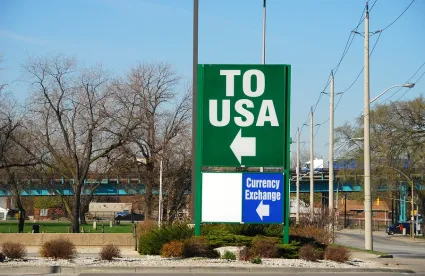Executive Order (EO) 13867 is the most recent in a series of EOs issued by President Trump in an effort to cut through red tape in infrastructure permitting – particularly for energy infrastructure and even more particularly for energy export infrastructure. The unique aspect of this order is that it directly asserts presidential authority and, thus, should be relatively impervious to bureaucratic inertia. While it remains to be seen whether all of its objectives will be achieved, it should, at the very least, stir rigorous discussion that could result in progress.
Background
On April 10, President Trump signed EO 13867, exercising his constitutional authority over foreign affairs to revoke certain previous delegations of authority to the State Department and assert exclusive authority to grant or deny presidential permits for construction, connection, operation or maintenance of certain infrastructure projects at an international border of the US (cross-border infrastructure). This action appears to be predicated on decisions such as the Keystone Pipeline and Alberta Clipper cases, which held that, particularly where permit authority is not based on a federal statute (as is the case with crude oil pipelines), the President has inherent constitutional authority to issue presidential permits and the permit issuance process is not subject to the Administrative Procedure Act (APA) or the National Environmental Protection Act (NEPA). Thus, by “taking back” authority previously delegated to the State Department, the President asserts singular authority to expedite (or delay or reformulate) the permitting process for the infrastructure projects, such as Alberta Clipper and Keystone XL, that have up to this point been conducted by the State Department.
It is important to note that this new, relatively unfettered authority does not apply to cross-border natural gas pipelines or electric transmission lines with respect to which authority remains delegated to the Federal Energy Regulatory Commission (FERC) and the Department of Energy (DOE) pursuant to EOs 10485 and 10530 issued by President Eisenhower in 1953 and 1954. It does, however, apply to all of the projects that were covered by the State Department delegation orders (EOs 13337 and 11423), which the new EO repeals.
Goals of the Executive Order – Expediting Presidential Permits
The EO states that, over the years, presidential permits have become “unnecessarily complicated” by requirements for review by multiple federal agencies. To reduce this complexity, the President revokes the prior delegation to the State Department and retains exclusive decision-making authority over those permits.
Presidential permits covered by the EO consist of:
- Pipelines (other than natural gas pipelines covered by section 3 of the Natural Gas Act), conveyor belts, and similar facilities for exportation or importation of all products to or from a foreign country
- Facilities for the exportation or importation of water or sewage to or from a foreign country
- Facilities for the transportation of persons or things, or both, to or from a foreign country
- Bridges, to the extent that congressional authorization is not required
- Similar facilities above or below ground
- Border crossings for land transportation, including motor and rail vehicles, to or from a foreign country
Next Steps
Significant issues to be addressed in these procedures will likely include:
- The precise scope of the EO’s coverage:
- Does it apply only to facilities crossing the border or to “facilities at the border”?
- How does the President’s authority over foreign relations relate to DOE’s statutory authority to grant the export of natural gas through pipelines?
- The extent of the EO’s effect:
- Does a federal agency’s authority to make recommendations implicate APA and NEPA even if the President’s decision does not?
There will, of course, be others.
The State Department is to adopt procedures to assure that all actions comprehended by the new presidential permitting process can be completed within 60 days after receipt of an application.



 />i
/>i


